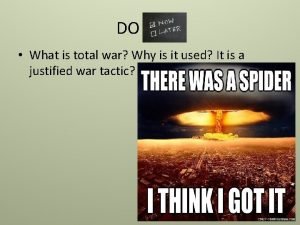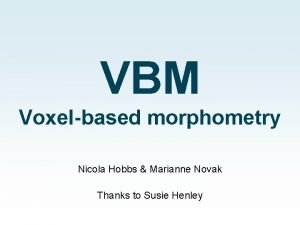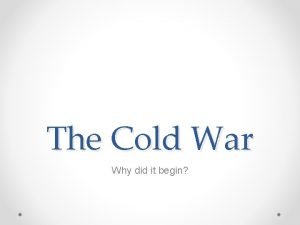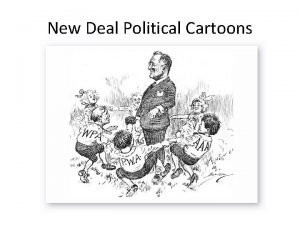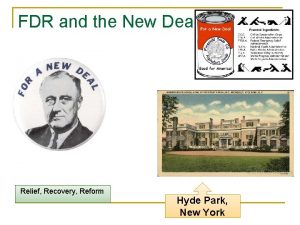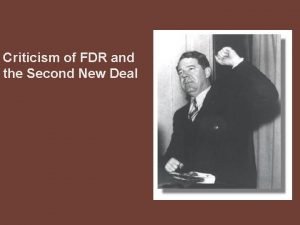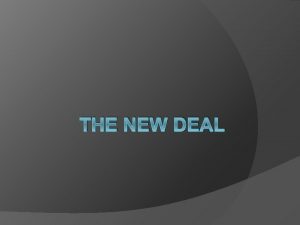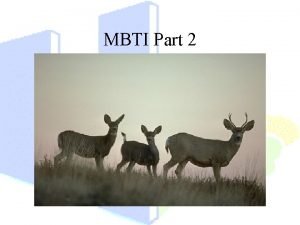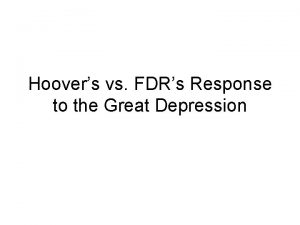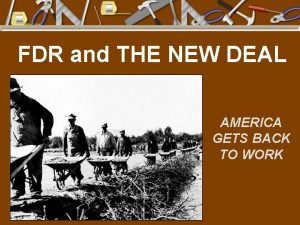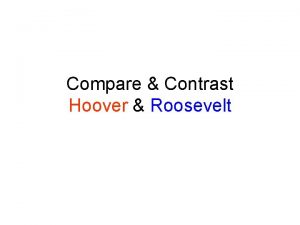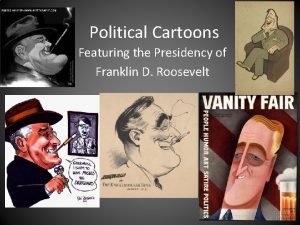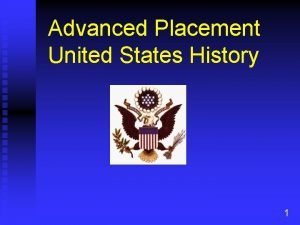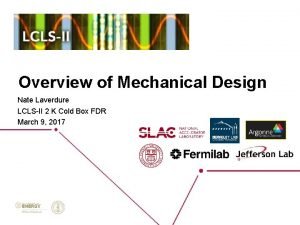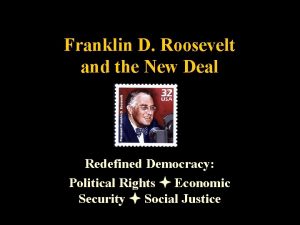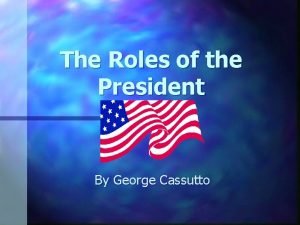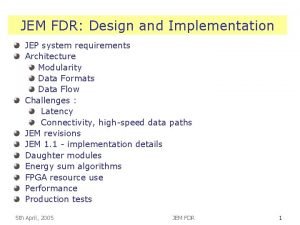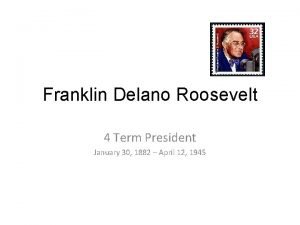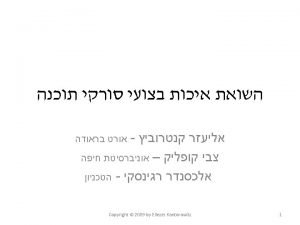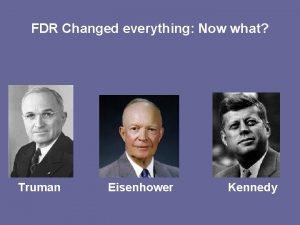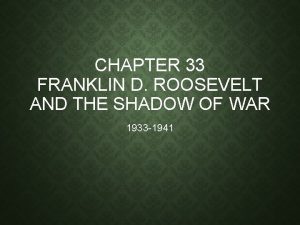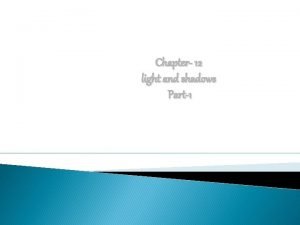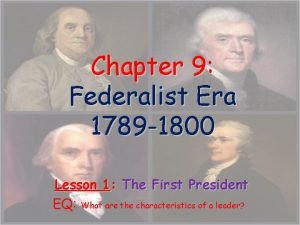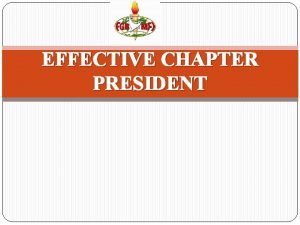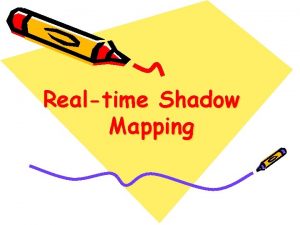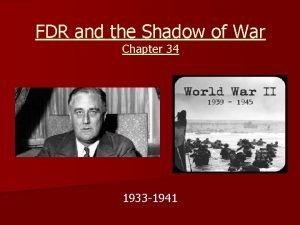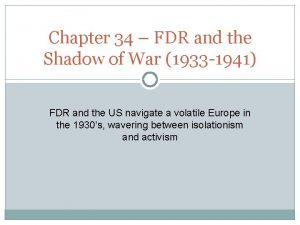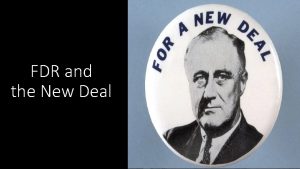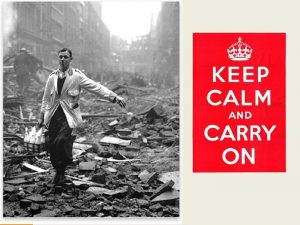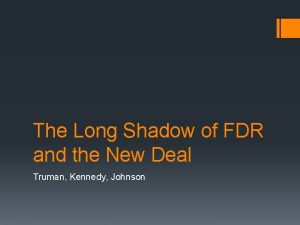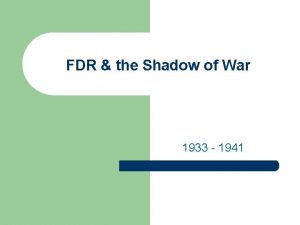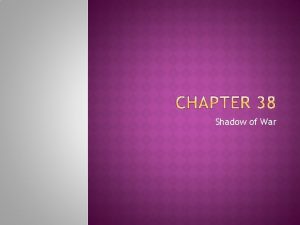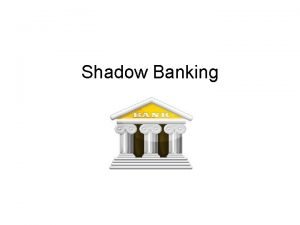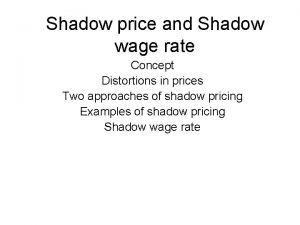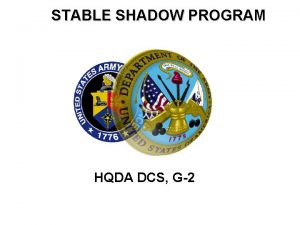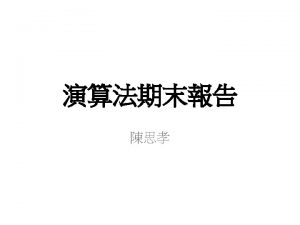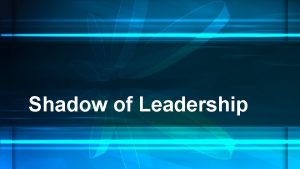CHAPTER 2 IN THE SHADOW OF FDR President

































- Slides: 33

CHAPTER 2 IN THE SHADOW OF FDR • President Truman’s Postwar Vision • Re-Conversion From war economy to a consumption economy • Splintering of Roosevelt Coalition- Labor Unrest and Southern Descent • Civil Rights • Election of 1948

FILM ANALYSIS: THE BEST YEARS OF OUR LIVES (1946)

PARADOXES: • Americans had come to expect the president to offer solutions to pressing social problems, but they also feared the expansion of Federal power. • Emphasis placed on the value of individuality and hard work, but suspicion towards collectivized bargaining and legislation that protects the rights of the employee over the owner. • People came to accept the New Deal and appreciate its programs, but many questioned the benefits of expanding it.

FROM WAR TO PEACE Changing Trends: • Since 1929, Americans had known nothing but sacrifice and hardship. Great Depression and World War II • In 1940 Families had 2. 6 children, 1950 - 3. 2 children • “Baby Boom” Between 1940 -1950: population grew by 14%- 19 mil. People • By 1945, 19 mil. Women worked outside the home • Many experienced stress from “double-duty” as home-maker and worker. • 2 million homes built, 1945 -1950: most outside cities in new communities called “suburbs, ” dominated by white and middle class groups

FROM WAR TO PEACE (CONT. ) • Between 1945 -1947 - 10 million soldiers discharged to civilian life, enter work force • Contracts and war production cut by 60%- 2. 7 million out of work. • National Debate- Should the “New Deal” be expanded Post-War Inflation • Reconversion- Policies to shift economy From war production to public consumption • People had plenty of money but few consumer products to buy • Prices soared due to demand • Employers demanded war-time price controls removed. • American workers demanded higher wages

HARRY S. TRUMAN • Last President to have not gone to college- family’s poverty kept him on father’s farm, could not afford college • WWI veteran- Captain of Artillery • Failed Businessman • Pendergast political machine- He owes rise in politics due to corrupt political boss. - Truman was known for honesty, integrity, and hard work. • Criticism of the President Then: A. He’s in over his head- Impulsive and Temperamental B. Not as popular and talented as Roosevelt C. Could not keep “New Deal” Coalition together D. Sees events unfolding too simplistically- Right/Wrong, Black/ White E. “Militarizing” Foreign Policy F. Overstepping his Presidential powers G. Expanding Federal Government influence and oversight into issues nongovernmental actors and state governments should solely handle H. Known as the “Accidental President”

READING AND RESPOND: • Read the document on Truman: • After analyzing, inferring, and writinga. Write if you think critics during his time were right about him? - an “accidental president” who does not have the skills or temperament to be president and abuses his power. b. What was Truman’s vision? How did Truman want to use the office of the presidency to change the role of government for the bettering of people’s lives?

SPLINTERING OF ROOSEVELT COALITION • Labor Disputes and Union Unrest • Civil Rights and Division of Democratic Party

UNION UNREST Labor Unrest: • 1945 - 30% of workforce was unionized • Contributing group to Roosevelt’s “New Deal” coalition • Unions provided millions of voters- had significant power In politics • During the war, unions make “no-strike” pledge to help war effort • 1945 -1946 “Strike Wave” - 19454, 750 strikes - Nov. 1945 - GM auto workers go on strike 113 days win 17. 5 % pay increase - 19464, 985 strikes - 400, 000 Coal Workers strike - Railroad Workers strike • Truman orders soldiers into the mines • Threatens to draft railroad workers • Series of trends and policies attacked unions’ strength in post-war economy

OPERATION DIXIE • Unionization effort in 1946 by the CIO- Congress of Industrial Organizations • Effort to unionize southern states • During the war and after the war, manufacturing moved to or expanded in southern states • CIO promoted equal rights for ALL workers- Black and White • Failures: - CIO supported national civil rights issues and called for integration. This enraged southern white workers. - CIO seen as “radical, ” during time of growing fear of Soviet Union had socialist and communist members. - local police and local businessmen conspired , sometimes even with the Ku Klux Klan, to break unions. Harassment of union organizers

PURGE OF COMMUNISTS • Socialists and Communist labor organizers played significant role in unionization of American industry in 1930 s • Passage of Taft-Hartley required Union members to pledge loyalty to the United States • At their height American communist party never totaled more than 50, 000 • Workers who refused to sign anti-communist affidavits were black listed by employers and labor unions.

POST-WAR ECONOMICS “Permanent War Economy” • Between June 1940 and Sept. 1944, U. S. gov’t paid $175 billion to 18, 000 companies in the form of military contracts • Period between 1945 -1947 - Reduction in Gov’t contracts - Reduction of over-time pay - Pay reductions and/or layoffs • After 1947, Marshall Plan and Cold War increase gov’t spending- “permanent arms economy” stabilizes: - Jobs and Wages for workers - Profits for industries • Defense and high-tech industries (aerospace, plastics, electronics) do very well during Cold War thanks to U. S. gov’t as big customer • Military budget includes much room for scientific R &D

UNION UNREST: OUTCOME • Most labor unions won pay increase to match inflation- 14% in 1947 • Many Americans did not support the strikes and Republicans regained control of House and Senate • Truman Vetoes, but Congress passes Taft-Hartley Act, 1947 - major revision of the National Labor Relations Act of 1935 (the Wagner Act) - President can intervene in a strike if it endangers the health and safety of the nations - Unions can only strike with 60 days notice - Declares “Closed Shops” illegal - A shop can only be unionized if workers vote for it - Forbids secondary “Solidarity” boycotts - Prohibits unions donating to political campaigns - Requires Union leaders to take oath stating they are not communist

STRUGGLE FOR CIVIL RIGHTS • In 1940 s- 1 million blacks left the south for the north • In 1950 s- 1. 5 million followed • More freedom and better jobs- discrimination and segregation still existed • Post-war migration and civil rights issues not addressed laid foundation for future “Urban Crisis” Civil Rights Milestones: • 1946 - Supreme Court rules segregation in interstate bussing unconstitutional • 1947 - Jackie Robinson integrates MLB and becomes rookie of the year • 1948 - S. C. finds restrictive covenants unconstitutional • 1948 and 1950 - segregation in institutions of higher education found unconstitutional • 1948 - Truman desegregates U. S. Military

DESEGREGATION OF THE MILITARY • October 1947, Truman called for anti-lynching and anti-poll tax laws, and strengthening the civil rights division of the Department of Justice. • Southern Senators blocked proposals • July 26, 1948, Executive Order 9981 stated that "there shall be equality of treatment and opportunity for all persons in the armed forces without regard to race, color, religion, or national origin. • 5 -Star General Omar Bradley, U. S. Army Chief of Staff resisted Truman’s calls on integration and claimed it would effect combat readiness • By 1950, Korean War- need for soldiers speeds up integration process

DOCUMENT ANALYSIS: • Why did Bradly not support Integration of the military? What was his main arguments.

1948 ELECTION De-Alignment -a trend or process whereby a large portion of the electorate abandons its previous partisan affiliation, without developing a new one to replace it. • Truman decides to push a strong civil-rights agenda : Gains support of Urban democrats • Dixie-crat revolt • “Beginning of end” for democrats in the south • First radio debate ever. • First Televised coverage • Things that make Truman look good: Economy recovers, Berlin blockade and Berlin airlift begin. Justifies Truman’s containment policy. • Truman fought a passionate campaign reminded voters Dem. Party led country through the Depression and WWII.

• Southern Democrats were not reliable “New Deal” supporters DIXIECRAT REVOLT- • They valued “class solidarity” with working people but did not like: a. increase of Federal powers b. any policy that took powers away from state/ mandated national rules and standards c. Civil rights/ Integration • Not a single southern politician supported Truman’s calls for civil rights in 1948 • Led by Conservative Democrats from Mississippi and Alabama, mostly southern elites who wanted to maintain the status quo • They did not want to split from the Dem. Party, but deny Truman widespread support and regain control within the party • Moderate politician and south Carolina Governor Strom Thurmond became Candidate for President. • Defended Jim Crow laws

HENRY WALLACE AND PROGRESSIVE PARTY • Sec. of Agriculture and 33 rd Vice President of U. S. - Henry Wallace becomes candidate • Replaced by Truman as V. P. • Ardent “New-Deal” supporter • As Candidate: a. Advocated closer ties with Soviet union b. Arms Reduction/ Decrease Defense budget c. Greater powers for the United Nations d. Increase In Foreign Aid

THOMAS DEWEY AND REPUBLICAN PARTY • Republicans felt confident in 1948 • Progressive-Republican (Centrist) New York Governor Thomas Dewey was believed certain to win • Dewey reminded voters he was an efficient and honest politician- former lawyer and prosecutor who fought organized crime • Fought a campaign without controversy nor promising anything that might upset one group of voters - Support for civil rights and integration in military - Pro-business policies and tax cuts - Social welfare programs similar to Truman

Election of 1948 Campaign Pledges Progressives. Wallace Democrats. Truman Republicans. Dewey States’ Rights Democrats (Dixie-crats) Thurmond • • • • • • Tame “Big-Business” Repudiation of Truman Doctrine Closer ties with Soviet Union Abandon overseas bases International recovery thru the U. N. Abolition of Nuclear Weapons Recognition of Israel Puerto Rican independence Civil Rights Repeal Taft-Hartley Subsidized Farming Housing • • • Anti-Soviet foreign policy Recovery of Europe- Marshall Plan Support of U. N. Recogn. Of Israel Civil Rights Repealing Taft. Hartley National Health Insurance Minimum Wage Subsidized Farming Housing • • Anti-Soviet Foreign Policy Recovery of Europe Support for the U. N. Recogn. Of Israel Support for Nationalist China Moderate critic of New Deal Minimum government interference in the economy Reduce Debt Reduce Waste Reduce Taxes Civil Rights Pledge to reconsider labor laws Conservation of Natural Resources Housing • • Anti-Communist Foreign Policy Strict adherence to the Constitutional rights of the “state” Bureaucratic powers of democrats and republicans is totalitarian Home Rule Local self-government Individual rights Segregation


ELECTION OF 1948 OUTCOME: • In 1946 - Majority of Americans voted Republican, giving indication most were tired of New Deal legislation • Congressional and governor sweep for Democrats

THE “FAIR DEAL” • Election of 1948 - Democrats regain majority in House and Senate • 1949 State of Union Address- Truman believed he had mandate for sweeping Liberal Reforms • “Every segment of our population and every individual has the right to expect from our government a Fair Deal” • Congress showed little support for programs that went beyond the New Deal • Republicans and southern democrats blocks Truman’s proposals • Cold War drained political capital and resources away from domestic and social efforts • To fulfill foreign policies, Truman needed to compromise with conservatives at home

FAIR DEAL Policies Passed Policies Denied • Raises minimum wage • Federal Aid to education • 400, 000 refugees allowed into country • Farm subsidies • National Housing Act, 1949 - 810, 000 low-income houses built • Repeal of Taft-Hartley • Social security benefits increased by 80% • Anti-Lynching Legislation • Allowed coverage for 10. 5 million more people • National Health Insurance • Abolition of Poll Tax • Creation of Civil Rights Division in Dept. of Justice

THE VITAL CENTER • Main Paradoxes of this Chaptera. Americans had come to expect the president to offer solutions to pressing social problems, but they also feared the expansion of Federal power. b. The New Liberalism of Truman created unrealistic expectations and possibilities of change • What are some examples from what we covered that you can point out?

THE VITAL CENTER • Large-scale economic planning during the war restored people’s faith in capitalism and governments ability to regulate the economy • Growing consensus- government should provide services not offered by private sector. Economic growth after the war and constant tax revenue allowed U. S. to provide resources for social programs and fighting the Cold War • America’s role in the world expands- Russian aggression in 1940 s seen as same as Germany’s belligerence in the 1930 s. Truman shifts America towards Aggressive internationalism. Enlarges definition of “American Interests” • Consensus and Social harmony was maintained as long prosperity was maintained. Ideological differences/ Racial/ Gender issues muted as long as prosperity brought some sense of opportunity.

POST-WAR ECONOMICS • Concern about return of depression after defense plants close down / gov’t sells off factories • Removal of wartime price controls causes prices to skyrocket (1946 -47) • Workers go on strike and try to claim wages to compensate for this inflation • Beginning of anti-labor legislation (Taft-Hartley Act)

POST-WAR ECONOMICS • Truman & Democrats try to continue Keynesian (consumer-sided) approach after war • Employment Act of 1946 (compromise between free marketers and Keynesians) creates 3 -member Council of Economic Advisers to provide president w/ policy recs • Gov’t policy “to promote maximum employment, production, and purchasing power”

POST-WAR ECONOMICS GI Bill (1944) • Generously provided for vets’ (15 million) school tuition • Most attend voc-tech schools, but others go to colleges • VA guarantees billions of $ in loans for vets to buy homes, farms, and small businesses • Considered to play a large role in postwar economic expansion

POST-WAR ECONOMICS • By 1950, U. S. economy sustains huge growth for two decades • “middle class” doubles from pre-Depression era / includes 60% of American people by mid ‘ 50 s (not everyone is included!) • most American families own washing machines, cars, and a television

POST-WAR ECONOMICS Cheap energy • US / European companies have control over petroleum exports from Middle East: keep prices low • Americans double oil consumption (1945 -70): interstate highways, air conditioning, expand electricity capacity x 6 (for industrial, commercial, and residential purposes)

POST-WAR ECONOMICS • Worker productivity (more mechanization) allows for greater output of goods • Further mechanization of agriculture + new fertilizers = more output • Gov’t subsidies for agriculture as well
 Fdr dies truman becomes president
Fdr dies truman becomes president Ducks unlimited checks
Ducks unlimited checks Fdr q value
Fdr q value Fdr
Fdr Fdr new deal political cartoon
Fdr new deal political cartoon Fdr three rs
Fdr three rs Criticism of fdr
Criticism of fdr Fdr
Fdr Mbti innovateur
Mbti innovateur 1932 electoral map
1932 electoral map New deal fdr
New deal fdr Compare and contrast hoover and fdr
Compare and contrast hoover and fdr Bull headed inaction
Bull headed inaction Fdr died
Fdr died Fdr
Fdr Enoxoparine
Enoxoparine Fdr election map
Fdr election map Fdr as chief legislator
Fdr as chief legislator Fdr design
Fdr design Fdr
Fdr Wows fdr
Wows fdr Fdr vps
Fdr vps Chapter 33 franklin d roosevelt and the shadow of war
Chapter 33 franklin d roosevelt and the shadow of war How are shadow formed
How are shadow formed Chapter 9 the federalist era
Chapter 9 the federalist era Fgbmfi vision and mission
Fgbmfi vision and mission Hình ảnh bộ gõ cơ thể búng tay
Hình ảnh bộ gõ cơ thể búng tay Frameset trong html5
Frameset trong html5 Bổ thể
Bổ thể Tỉ lệ cơ thể trẻ em
Tỉ lệ cơ thể trẻ em Chó sói
Chó sói Tư thế worm breton
Tư thế worm breton Bài hát chúa yêu trần thế alleluia
Bài hát chúa yêu trần thế alleluia Các môn thể thao bắt đầu bằng tiếng bóng
Các môn thể thao bắt đầu bằng tiếng bóng
